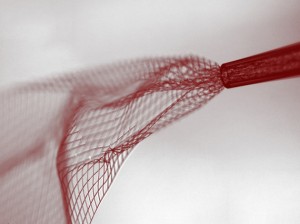Jun 09 2015
Injectible Brain Electrodes
 Charles Lieber with his team at Harvard University have developed a flexible mesh network of electrodes that can be injected through the skull, unfolding onto the surface of the brain. This technology could be a significant advance in our ability to study the brain.
Charles Lieber with his team at Harvard University have developed a flexible mesh network of electrodes that can be injected through the skull, unfolding onto the surface of the brain. This technology could be a significant advance in our ability to study the brain.
Neuroscientists are trying to map the brain in as much detail as possible, creating what is being called the “connectome” (reminiscent of mapping the human “genome”).
There are about 87 billion neurons in the adult human brain. Each neuron is capable of making up to around 10,000 connections to other neurons, which means the total connections in the brain is somewhere around a quadrillion. The saying goes that neurons that wire together fire together, so the pattern of connections determines the pattern of electrical activity in the brain.
There are some non-trivial technical limitations when it comes to mapping the brain. One main one is resolution – current technology is limited to recording clusters of neurons firing in a living brain. We can get down to the single neuron when looking at neurons in a petri dish. This new technology promises single-neuron resolution in a living brain.
Scalp electrodes are easiest and safest, but have the worst resolution. As we get more invasive, potential resolution gets much better. Brain surface electrodes are much better than scalp electrodes, and implanted electrodes within the brain are better still. The trick is getting large numbers of tiny electrodes to mesh with brain tissue. That is exactly what this new technique involves.
The researchers have implanted a small mesh a few centimeters wide with 16 electrodes into rat brains. The mesh is flexible, so it can maintain its connection to single neurons even as the brain pulses and moves with the pulsations of blood flow. The mesh also contains nanowires that allow for both recording from single neurons and stimulating single neurons. The rat brains also seem to accept the mesh without significant damage.
The researchers now need to implant larger meshes, and gather more safety data before moving onto human trials. The hope is that eventually large versions of this electrode mesh can be safely implanted in human brains where it can remain for long periods of time. This will allow studying brain activity with neuron-level resolution.
Electrodes, however, also give us the opportunity to affect brain function. One application of this is treating diseases like Parkinson’s disease and epilepsy. This is already being done, by placing wires in specific locations within the brain. This new technology might provide another option, but of course it is too early to tell what its precise therapeutic applications will be.
High resolution brain electrodes also can be used for brain-machine interfaces. Already people can control computers or robotic arms purely by thought through electrodes that read the electrical activity of their brain. The greater the resolution, the finer the level of control. There is also a need for safe implants that can be left in for a long time.
Conclusion
Overall this is a small but noteworthy advance in modern neuroscience. Right now we are engaged in several parallel research programs within neuroscience, all with great promise: We are mapping the brain’s connectome, we are trying to simulate the brain with computer software and hardware (essentially AI research), and we are trying to interface brains and computers.
These research programs all play off each other. Already there are specific applications of this technology, such as the brain stimulation treatments I mentioned above. It seems very likely that within a generation we will have advancing neural-prosthetics.
As I always point out, it is very difficult to predict technological advance, especially in the medium term. We can make confident predictions about 5-10 years, because that is the length of the pipeline of just bringing developed ideas to fruition. Unexpected roadblocks do crop up, but we can often see technology coming that far away. Ten to 50 years or so is very difficult to predict. We tend to overestimate progress in this window and often have a difficult time predicting which technologies will pan out.
Beyond 50 years we have virtually no chance of making specific predictions, but it becomes perhaps easier to make very broad predictions. We also tend to underestimate long term progress.
For this technology, in the medium term, it is likely we will see significant advance in all three areas – mapping the brain, artificial intelligence, and brain-machine interface. How much, however, is difficult to say. The longer term we try to predict the easier it is to say that we will make significant progress leading to interesting applications. Although I would not try to predict specific details, it seems very likely that within 100 years we will have mature versions of all three technologies.






